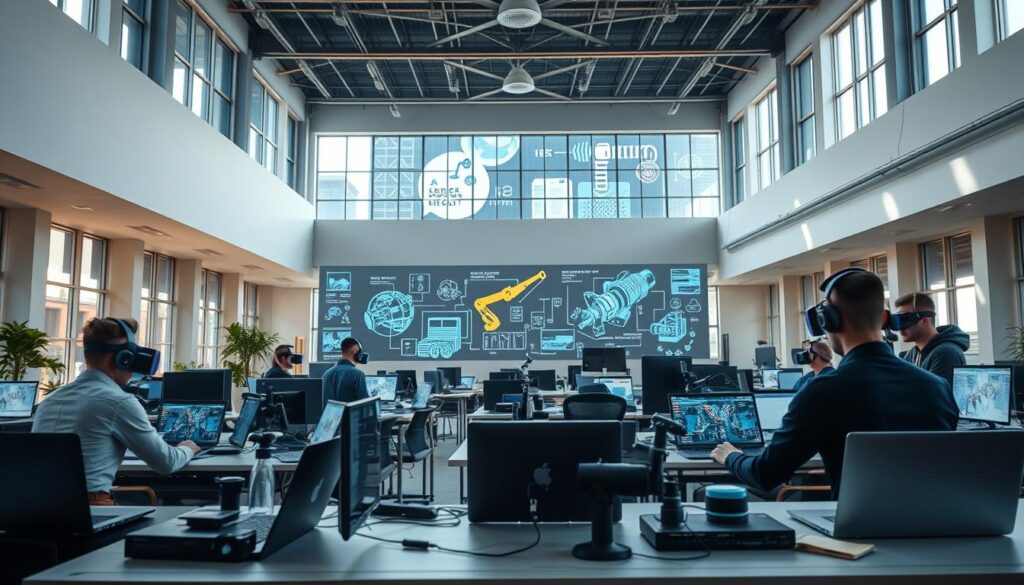Can businesses truly thrive in today’s fast-paced environment without leveraging the latest technological advancements? The answer lies in embracing innovative solutions that enable companies to manage complex projects efficiently.
The concept of remote site engineering is revolutionizing the way businesses operate, allowing them to oversee projects from anywhere in the world. With the advancement of technology, this approach is becoming increasingly popular among companies looking to improve efficiency and reduce costs.
By adopting remote site engineering services, businesses can enhance collaboration, reduce the need for physical presence, and expand their operations more effectively.
Key Takeaways
- Innovative solutions enable businesses to manage complex projects efficiently.
- Remote site engineering allows companies to oversee projects from anywhere.
- This approach enhances collaboration and reduces costs.
- Businesses can expand their operations more effectively.
- Leveraging the latest technologies is crucial for success.
What is Remote Site Engineering?
Remote site engineering involves the application of cutting-edge technologies to facilitate the remote execution of engineering projects. This approach has transformed the way complex projects are managed, enabling greater efficiency, reduced costs, and enhanced collaboration.
Definition and Overview
Remote site engineering encompasses a range of services, including virtual site construction, remote infrastructure development, and off-site project engineering. By leveraging advanced digital tools for design, simulation, and project management, businesses can improve project outcomes and reduce the need for physical presence on site.
Key Features
The key features of remote site engineering include the use of advanced technologies such as drones, remote sensing tools, and virtual reality applications. These technologies enable real-time monitoring, precise data collection, and enhanced collaboration among project stakeholders. As noted in a recent article on the future of civil engineering, the integration of such technologies is set to revolutionize the industry.
Importance in Modern Business
In today’s fast-paced business environment, remote site engineering plays a crucial role in driving project efficiency and reducing costs. By adopting remote engineering services, companies can stay competitive, improve project delivery times, and enhance overall quality. The importance of remote site engineering is underscored by its ability to facilitate remote infrastructure development and virtual site construction, making it an indispensable tool for modern businesses.
Benefits of Remote Site Engineering
The shift towards remote site engineering has unlocked new opportunities for growth and efficiency. By leveraging advanced technologies, businesses can improve their operations in various ways.

Cost Efficiency
One of the key benefits of remote site engineering is cost efficiency. By reducing the need for physical presence, businesses can save on travel and accommodation costs. According to industry experts, “remote site engineering can significantly reduce operational expenses”
“The future of engineering is remote, and it’s changing how we work,”
said a leading expert in the field, highlighting the potential for cost savings.
For instance, remote engineering enables teams to manage projects effectively without being on-site, thus cutting down on unnecessary expenditures.
Increased Productivity
Remote site engineering also leads to increased productivity. With the use of online construction management tools, teams can monitor and control projects in real-time, ensuring that tasks are completed efficiently.
A notable example is the use of remote project planning tools, which facilitate effective communication among team members and stakeholders, thereby enhancing overall productivity.
Enhanced Collaboration
Furthermore, remote site engineering fosters enhanced collaboration. By utilizing advanced communication platforms, teams can collaborate more effectively, regardless of their geographical location.
For example, professionals can access online civil engineering courses to improve their skills, thereby contributing to more effective collaboration in remote site engineering projects.
Key Technologies in Remote Site Engineering
The growth of remote site engineering is driven by several key technologies that are transforming the industry. These technologies enable businesses to improve project outcomes, reduce costs, and enhance collaboration.
Drones and Aerial Surveying
Drones and aerial surveying are becoming increasingly popular in remote site engineering. These technologies enable businesses to capture accurate data and monitor project progress in real-time. By leveraging drones and aerial surveying, companies can reduce the need for physical site visits, improving safety and efficiency.
Remote Sensing Tools
Remote sensing tools are another crucial technology in remote site engineering. These tools allow for the collection of data from a distance, reducing the need for on-site personnel. This technology is particularly useful for monitoring environmental conditions, detecting changes, and predicting potential issues.
Virtual Reality Applications
Virtual reality (VR) applications are enhancing the field of remote site engineering by providing immersive experiences for training and project visualization. VR enables teams to better understand complex projects, improving planning and execution. For more information on tools that can be used in remote site engineering, visit must-have tools for site engineers.
Communication Platforms
Effective communication is critical in remote site engineering, and advanced communication platforms are facilitating this process. These platforms enable real-time collaboration, file sharing, and instant messaging, ensuring that teams stay connected and informed throughout the project lifecycle.
By adopting these key technologies, businesses can significantly improve their remote site engineering capabilities, leading to more successful project outcomes and a competitive edge in their respective industries.
Industries That Benefit from Remote Site Engineering
Industries worldwide are leveraging remote site engineering to improve collaboration, reduce costs, and drive project success. By adopting remote engineering services, businesses can enhance project outcomes and stay competitive in their respective markets.
Construction and Infrastructure
The construction and infrastructure sector is one of the primary beneficiaries of remote site engineering. Projects can be monitored in real-time, allowing for prompt issue resolution and reducing delays. Remote site engineering also enables the use of advanced technologies like drones for site surveying and monitoring.

According to a recent report, the use of remote monitoring technologies in construction has led to a significant reduction in project costs and improved overall efficiency. As stated by a construction industry expert, “Remote site engineering has revolutionized our approach to project management, enabling us to deliver projects on time and within budget.”
Oil and Gas
The oil and gas industry benefits greatly from remote site engineering, particularly in the monitoring and maintenance of infrastructure. Remote sensing tools allow for the early detection of potential issues, reducing the risk of accidents and environmental damage.
| Industry | Benefits of Remote Site Engineering |
|---|---|
| Oil and Gas | Enhanced safety, reduced maintenance costs |
| Construction | Improved project monitoring, reduced delays |
Renewable Energy
In the renewable energy sector, remote site engineering plays a crucial role in the development and maintenance of infrastructure such as wind farms and solar panels. Remote monitoring systems enable the optimization of energy production and reduce operational costs.
“The integration of remote site engineering in renewable energy has been a game-changer, allowing us to maximize energy output while minimizing costs.”
Telecommunications
The telecommunications industry relies on remote site engineering for the installation, maintenance, and monitoring of network infrastructure. Remote access technologies enable technicians to troubleshoot and resolve issues without being physically present, reducing downtime and improving service quality.
- Enhanced network reliability
- Reduced maintenance costs
- Improved customer satisfaction
In conclusion, remote site engineering is transforming various industries by providing innovative solutions, enhancing collaboration, and driving project success. As technology continues to evolve, the adoption of remote site engineering is expected to grow across different sectors.
Challenges in Remote Site Engineering
Remote site engineering, despite its numerous benefits, faces several challenges that need to be addressed for successful project execution. As organizations increasingly adopt remote engineering services for their projects, understanding these challenges becomes crucial.
One of the primary challenges is connectivity issues. Reliable internet connectivity is essential for virtual site construction and online construction management. However, remote sites often suffer from poor or inconsistent internet connectivity, hindering the effectiveness of remote engineering services.
Connectivity Issues
Connectivity issues can significantly impact the productivity and efficiency of remote site engineering projects. For instance, real-time data transfer and communication between the remote site and the central office can be compromised due to poor connectivity.
According to a study on the impact of remote work on engineering, connectivity issues are among the top challenges faced by organizations adopting remote site engineering practices. The study highlights the need for robust and reliable connectivity solutions to support remote engineering projects.
Data Security Concerns
Data security is another significant challenge in remote site engineering. With the increased reliance on digital technologies and online construction management systems, ensuring the security of project data becomes paramount.
Organizations must implement robust security measures to protect sensitive project information from cyber threats. This includes using secure communication protocols, encrypting data, and conducting regular security audits.
“The security of our data is as important as the success of our projects. Implementing robust security measures is crucial in today’s digital age.”
Training and Skill Gaps
The adoption of remote site engineering also requires personnel with the right skills and training. There is a need for professionals who are adept at using remote engineering services and managing projects remotely.
Organizations should invest in training programs that address these skill gaps, ensuring that their teams are equipped to handle the challenges of remote site engineering effectively.
In conclusion, while remote site engineering offers numerous benefits, it also presents several challenges that need to be addressed. By understanding and mitigating these challenges, organizations can ensure the successful execution of their remote site engineering projects.
Best Practices for Remote Site Engineering Projects
The success of remote site engineering projects hinges on adopting effective best practices. By leveraging virtual engineering solutions and remote site monitoring, businesses can significantly improve project outcomes and reduce costs. Effective planning and management are critical components of successful remote site engineering projects.
Effective Planning and Management
Effective planning and management are crucial for the success of remote site engineering projects. This involves utilizing advanced project management tools and techniques to ensure that projects are completed on time and within budget. Key aspects include:
- Defining clear project objectives and scope
- Establishing a robust project schedule
- Identifying and mitigating potential risks
- Ensuring effective communication among team members
Utilizing the Right Tools
The right tools are essential for the successful execution of remote site engineering projects. This includes remote monitoring systems, drones, and other advanced technologies that enhance data collection and analysis. By utilizing these tools, businesses can:
- Improve data accuracy and reduce manual errors
- Enhance collaboration among team members
- Increase productivity and efficiency

Stakeholder Engagement
Stakeholder engagement is vital for the success of remote site engineering projects. This involves maintaining open lines of communication with all stakeholders, including project team members, clients, and external partners. Effective stakeholder engagement ensures that everyone is aligned with project goals and progress.
- Regular updates and progress reports
- Transparent communication channels
- Inclusive decision-making processes
By adopting these best practices, businesses can ensure the successful execution of remote site engineering projects, achieving improved outcomes and reduced costs.
Case Studies: Success Stories in Remote Site Engineering
Through the lens of several case studies, we explore the impact and success of remote site engineering across different industries. These examples highlight the versatility and effectiveness of remote site engineering in achieving project goals.
Successful Construction Projects
Remote infrastructure development has significantly improved project outcomes in the construction industry. For instance, a leading construction company utilized remote engineering services to manage a large-scale infrastructure project, resulting in enhanced efficiency and reduced costs.
The use of advanced technologies such as drones and aerial surveying enabled the company to monitor progress in real-time, identify potential issues early, and make data-driven decisions. This approach not only improved project timelines but also ensured compliance with safety regulations.
| Project Aspect | Traditional Method | Remote Site Engineering |
|---|---|---|
| Project Monitoring | Periodic site visits | Real-time monitoring using drones |
| Issue Identification | Manual inspection | Automated data analysis |
| Decision Making | Based on periodic reports | Data-driven decisions in real-time |
Innovations in Energy Sector
Off-site project engineering has been a game-changer in the energy sector, particularly in renewable energy projects. By leveraging remote sensing tools and virtual reality applications, companies can now design, manage, and optimize energy projects more efficiently.
“The integration of remote site engineering technologies has revolutionized our approach to energy project management, enabling us to reduce costs and improve project outcomes.” –
The use of remote monitoring systems allows for the early detection of potential issues, minimizing downtime and optimizing energy production. This has been particularly beneficial in the management of remote or hard-to-reach energy infrastructure.
Advancements in Telecommunications
Online construction management has transformed the telecommunications industry by enabling the efficient deployment of network infrastructure. Through the use of remote site engineering, telecommunications companies can now manage complex projects more effectively, ensuring timely completion and reducing operational costs.
The application of remote collaboration tools has facilitated communication among project stakeholders, ensuring that all parties are aligned and informed throughout the project lifecycle. This has been crucial in managing large-scale telecommunications projects.
By adopting remote site engineering practices, telecommunications companies can improve their competitiveness and deliver high-quality services to their customers.
How to Choose a Remote Site Engineering Partner
The process of selecting a remote site engineering partner requires careful consideration of several key factors. With the rise of remote engineering services, businesses have a wide range of options to choose from, each with its unique strengths and capabilities.
To make an informed decision, it’s crucial to assess the potential partner’s expertise and experience in handling projects similar to yours. This involves looking into their past projects, understanding their approach to virtual site construction, and evaluating their ability to manage complex engineering tasks remotely.
Assessing Expertise and Experience
When assessing a potential partner’s expertise and experience, consider the following factors:
- Their track record in delivering successful remote site engineering projects
- Their expertise in utilizing cutting-edge technologies for remote project planning
- Their ability to adapt to changing project requirements
For more insights on choosing the right team structure for your project, you can refer to this article on selecting appropriate software engineering teams.
Evaluating Technology Proficiencies
A remote site engineering partner’s technology proficiencies play a critical role in determining their ability to deliver high-quality results. Some key technologies to look out for include:
| Technology | Application | Benefits |
|---|---|---|
| Drones and Aerial Surveying | Site surveying, monitoring | Enhanced accuracy, reduced costs |
| Remote Sensing Tools | Data collection, monitoring | Real-time data, improved decision-making |
| Virtual Reality Applications | Project visualization, training | Improved collaboration, enhanced training |
Understanding a potential partner’s proficiency in these technologies can help you gauge their capability to handle your project’s specific needs.
Understanding Service Offerings
It’s also essential to understand the range of services offered by your potential remote site engineering partner. This includes:
- Project planning and management
- Design and engineering services
- Construction monitoring and support

By carefully evaluating these aspects, you can select a remote site engineering partner that meets your project’s needs and contributes to its success.
The Role of Sustainability in Remote Site Engineering
Sustainability is becoming a cornerstone in remote site engineering, driven by the adoption of eco-friendly technologies. As businesses increasingly prioritize environmental responsibility, the integration of sustainable practices in remote site engineering is transforming the way projects are managed and executed.
Eco-Friendly Technologies
The use of eco-friendly technologies is a critical component of sustainable remote site engineering. Virtual engineering solutions enable businesses to reduce their reliance on physical resources, minimizing environmental impact. For instance, drones and remote sensing tools allow for accurate site monitoring without the need for extensive ground travel, reducing carbon emissions.
Moreover, advancements in virtual reality applications facilitate immersive training and project visualization, further decreasing the need for physical prototypes and site visits. This not only enhances efficiency but also contributes to a more sustainable operational model.
Reducing Environmental Impact
Remote site engineering plays a significant role in reducing environmental impact through remote site monitoring. By leveraging real-time data and monitoring systems, businesses can identify potential environmental hazards early, taking proactive measures to mitigate them. This includes monitoring weather conditions, soil erosion, and wildlife habitats, ensuring that projects are executed with minimal ecological disruption.
Furthermore, the use of sustainable materials and practices in remote site engineering projects contributes to a reduced environmental footprint. This includes the adoption of renewable energy sources, such as solar and wind power, to support remote site operations.
Compliance with Regulations
Ensuring compliance with environmental regulations is a crucial aspect of sustainable remote site engineering. Businesses must navigate a complex landscape of local, national, and international regulations designed to protect the environment. By implementing robust remote site monitoring systems, companies can demonstrate compliance and avoid potential legal and financial repercussions.
Additionally, adopting sustainable practices and technologies not only ensures regulatory compliance but also enhances a company’s reputation and competitiveness in the market. As sustainability continues to be a driving force in the industry, businesses that prioritize eco-friendly solutions are better positioned for long-term success.
Future Trends in Remote Site Engineering
As we look ahead, remote site engineering is set to be revolutionized by several key trends. The integration of cutting-edge technologies and innovative methodologies will significantly impact how remote site engineering projects are managed and executed.
Integration of AI and Machine Learning
The incorporation of Artificial Intelligence (AI) and Machine Learning (ML) into remote site engineering will enhance predictive analytics, automate routine tasks, and improve decision-making processes. AI and ML algorithms can analyze vast amounts of data to predict potential issues, optimize resource allocation, and streamline project timelines.
For instance, AI-powered predictive maintenance can help prevent equipment failures, reducing downtime and increasing overall project efficiency. Machine learning models can also be trained to identify patterns in data, enabling more accurate forecasting and better risk management.
Growth of Remote Monitoring Systems
Remote monitoring systems are becoming increasingly sophisticated, allowing for real-time tracking of project progress, environmental conditions, and equipment performance. These systems utilize IoT devices, sensors, and drones to collect data, which is then analyzed to inform project decisions.
The growth of remote monitoring systems will lead to improved project visibility, enhanced safety, and reduced costs. By leveraging these systems, project managers can respond promptly to issues, mitigate risks, and ensure compliance with regulatory requirements.
Evolution of Remote Collaboration Tools
The future of remote site engineering will also be shaped by the evolution of remote collaboration tools. These tools will become more intuitive, secure, and integrated, facilitating seamless communication and collaboration among project stakeholders.
Advanced collaboration platforms will enable real-time communication, document sharing, and project tracking, ensuring that all stakeholders are aligned and informed. This will lead to improved productivity, reduced misunderstandings, and enhanced project outcomes.

| Trend | Description | Benefits |
|---|---|---|
| AI and ML Integration | Predictive analytics, automation, and enhanced decision-making | Improved efficiency, reduced costs, and enhanced project outcomes |
| Remote Monitoring Systems | Real-time tracking of project progress and equipment performance | Enhanced project visibility, improved safety, and reduced costs |
| Remote Collaboration Tools | Intuitive, secure, and integrated platforms for stakeholder collaboration | Improved productivity, reduced misunderstandings, and enhanced project outcomes |
Training and Development in Remote Site Engineering
As remote site engineering continues to evolve, the need for skilled professionals who can effectively manage and execute projects has become increasingly important. The complexity of remote site engineering projects demands a workforce that is not only technically proficient but also adept in collaborative tools and methodologies.
To address this need, various certifications and courses are available to professionals in the field. These programs focus on enhancing technical skills, improving project management capabilities, and fostering effective collaboration in remote settings.
Certifications and Courses Available
Several organizations offer specialized certifications for remote site engineering professionals. For instance, courses in virtual site construction and remote infrastructure development are designed to equip professionals with the latest knowledge and skills.
- Certified Remote Site Engineer (CRSE)
- Virtual Construction Certification
- Remote Infrastructure Development Specialist
These certifications not only enhance a professional’s skill set but also significantly boost their credibility in the industry.
Importance of Continuous Learning
Continuous learning is crucial in the rapidly evolving field of remote site engineering. Professionals must stay updated with the latest technologies and methodologies to remain competitive. For more insights on managing remote civil engineering teams, visit this resource.
| Skill Area | Importance Level | Training Availability |
|---|---|---|
| Technical Skills | High | Yes |
| Project Management | High | Yes |
| Collaboration Tools | Medium | Yes |
Mentorship Opportunities
Mentorship plays a vital role in the development of remote site engineering professionals. Experienced mentors can provide valuable guidance, share best practices, and help mentees navigate complex projects.
By investing in continuous learning and mentorship opportunities, businesses can ensure that their teams have the necessary skills to execute remote infrastructure development projects successfully.
Conclusion: Embracing Remote Site Engineering for Future Success
Remote site engineering is transforming the way businesses operate, offering innovative solutions for project management and execution. By leveraging remote engineering services, companies can enhance their online construction management capabilities and improve remote project planning.
Key Takeaways
The benefits of remote site engineering include cost efficiency, increased productivity, and enhanced collaboration. As businesses continue to adopt this technology, it’s essential to understand the key concepts, benefits, and challenges associated with remote site engineering.
Adapting to Change
To stay ahead of the competition, businesses must be willing to adapt to the changing landscape of remote site engineering. This involves embracing new technologies and strategies that support online construction management and remote project planning.
Moving Forward
Businesses are encouraged to explore the possibilities of remote site engineering and adopt this technology to achieve future success. By doing so, they can improve project outcomes, reduce costs, and enhance collaboration, ultimately driving business growth and innovation.
